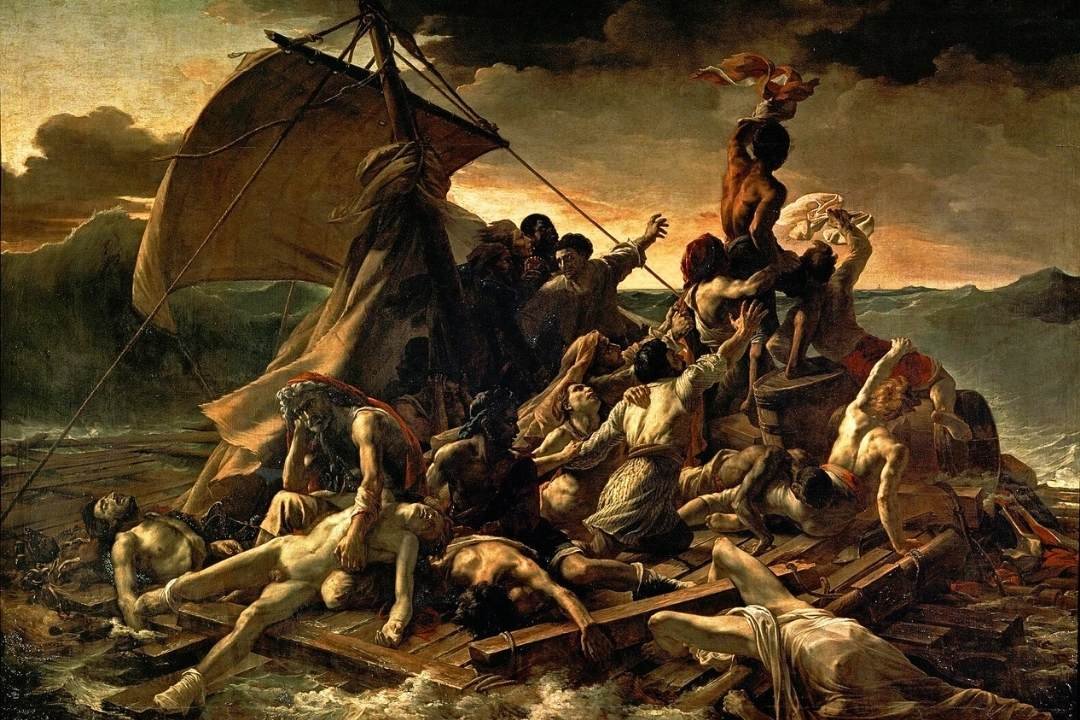Paris, Musée du Louvre
Considered an icon of Romantic art, few paintings have been so copied (or parodied) as this extraordinary raft. The scene, overflowing with writhing bodies and churning seas, is the artist’s take on a famous shipwreck off the coast of Senegal on 2 July 1816. The Medusa was a French Royal Navy frigate whose captain – appointed by the new Bourbon King Louis XVIII – was an aristocrat who had not been to sea in 20 years and ran the ship aground. There were not enough lifeboats and so 150 of the 400 souls aboard were set adrift in a makeshift raft for 13 harrowing days. Only ten survived the voyage, which descended into violence and cannibalism.
The report of two of the survivors caused a public outcry and when Géricault presented this painting at the Salon of 1819 it was seen as an affront to the king, who prohibited the painting’s title, as it recalled the tragic event caused by the king’s appointed captain. However Géricault was more interested in the drama of the subject than its politics; for him it was a vehicle to explore physical and mental suffering – a theme he later explored in portraits of the insane.
In his impassioned empathy for the victims of the Medusa, he drew out every aspect of their suffering. He interviewed the survivors and made sketches of them as well as of the dead and dying in hospitals and morgues. He then made a model raft with wax figurines and numerous sketched studies using live models (that included the young Delacroix) before deciding on this composition, which focuses not on the wreck or on the rescue of survivors but rather on the desperate time between the two.
On a craft that seems hardly sea-worthy, 20 odd bodies – some alive, some dead, others between the two – float. The entire composition pulls to the right in the direction of a futile hope: a distant ship. Some men are beyond caring; either unconscious or lost in despair, as one old man who slumps over the naked body of his dead son. But some sailors have roused themselves from their stupor in a last chance at rescue. They frantically wave but the ship does not see them and continues on. Despite the somewhat heavy-handed melodrama of the scene, the spectator cannot help but appreciate the inconsolable horror of the moment; for only ten will survive and their gruesome fate is now sealed.
The actual painting is massive (4.9 m x 7.2 m) and the scene, viewed from above with the foreground bodies unsettlingly close to the viewer, is filled with human misery. The work has been frequently compared with Michelangelo’s Last Judgement – which Géricault studied closely when he was in Rome in 1816–17 – in regard to its treatment of physical suffering. Michelangelo’s influence is evident in the deep chiaroscuro, which models forms and gives wild gesture even more drama. Géricault had also studied Gros’s Napoleon Visiting the Plague House in Jaffa and seems to try to pack in even more pallid bodies and pathos onto a canvas than Gros.
The reaction to The Raft at the Salon of 1819 was passionate but mixed. Some were fascinated by the sheer audacity of its subject not to mention its politics and liberalism; for it is an African who waves most energetically to save the crew. Le Journal de Paris wrote: ‘It strikes and attracts all eyes’. But others described the scene disdainfully as a ‘pile of corpses’ and thought its lack of classical principles appalling (the mostly self-taught Géricault had previously been criticised for not being able to draw). One commentator mocked: ‘Monsieur Géricault seems mistaken. The goal of painting is to speak to the soul and the eyes, not to repel’.
Luckily Géricault was independently wealthy and could afford to ignore criticism and paint what he wanted. Little interested in the previous generation’s neoclassicism, he painted pictures of raw emotion and physical tension, helping to define a generation of French Romantic painters.
Contemporary Works
1819 Caspar David Friedrich: On the Sailing Boat, St Petersburg, State Hermitage Museum
1819 John Constable: The White Horse, New York, Frick Collection
1819 J.M.W Turner: England: Richmond Hill, on the Prince Regent’s Birthday, London, Tate
Categories:
- French Nineteenth Century Painting
- Romanticism

